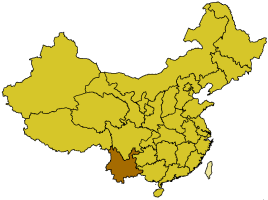This is an old revision of this page, as edited by Gadfium (talk | contribs) at 01:22, 8 October 2004 (Category:Provinces of China). The present address (URL) is a permanent link to this revision, which may differ significantly from the current revision.
Revision as of 01:22, 8 October 2004 by Gadfium (talk | contribs) (Category:Provinces of China)(diff) ← Previous revision | Latest revision (diff) | Newer revision → (diff)Yunnan (Simplified Chinese: 云南, Traditional: 雲南, pinyin: Yúnnán) is a province of the People's Republic of China, located in the far southwestern corner of the country.
| Province Abbreviation(s): 滇 (Diān) or 云 (Yún) | |
| Capital | Kunming (昆明) |
| Area - Total - % water | Ranked 8th 394,000 km² xx% |
| Population
- Density | Ranked 12th
109/km² |
| Administration Type | Province |
| Governor | Xu Rongkai |
 | |
History
Human life has been found in Yunnan as early as 1.7 million years ago, predating Peking Man of northern China by up to 1.5 million years. The remains of "Yuanmou Man" (元谋人), unearthed by railway engineers in the 1960s, have been determined to be the oldest in China. By the neolithic period, there were human settlements in the area of Lake Dian (滇池). These people used stone tools and constructed simple wooden structures.
Around the third century BC, the central area of Yunnan around present day Kunming was known as Dian. The Chu general Zhuang Qiao (庄跤) entered the region from the upper Yangzi River and set himself up as "King of Dian". He and his followers brought into Yunnan an influx of Chinese influence, the start of a long history of migration and cultural expansion.
In 221 BC, the Qin Shihuangdi unified China and extend his authority south. Commanderies and counties were established in Yunnan. A existing road in Sichuan was extended south to around present day Qujing (曲靖), in eastern Yunnan - called the "Five Foot Way". In 109 BC, Emperor Wu sent General Guo Chang (郭昌) south to Yunnan, establishing Yizhou commandery and 24 subordinate counties. The commandery seat was at Dianchi county (present day Jinning 晋宁). Another county was called "Yunnan", probably the first use of the name. To expand the burgeoning trade with Burma and India, Emperor Wu also sent Tang Meng (唐蒙) to maintain and expand the Five Foot Way, renaming it "Southwest Barbarian Way" (西南夷道). By this time, agricultural technology in Yunnan had markedly improved. The local people used bronze tools, plows and kept a variety of livestock, including cattle, horses, sheep, goats, pigs and dogs. Anthropoligists have determined that these people were related to the people now known as the Thai. They lived in tribal congregations, sometimes led by exile Chinese.
During the Three Kingdoms, the territory of present day Yunnan, Yuexi (黔西) and southern Sichuan was collectively called "Nanzhong" (南中). The disollution of Chinese central authority led to increased autonomy for Yunnan and more power for the local tribal structures. In 225 AD, the famed statesman Zhuge Liang (诸葛亮) led three columns into Yunnan to pacify the tribes. His seven captures of Meng Huo (孟获), a local magnate, is much celebrated in Chinese folklore.
In the fourth century, northern China was largely overrun by peoples from Central Asia. In the 320s, the Cuan (爨) clan migrated into Yunnan. Cuan Chen (爨琛) named himself king and held authority from Dianchi (then called Kunchuan 昆川). Henceforth the Cuan clan ruled Yunnan for over four hundred years. In 738, the kingdom of Nanzhao (南诏) was established in Yunnan by Piluoge (皮罗阁), who was confirmed by the imperial court of the Tang Dynasty as "King of Yunnan". Ruling from Dali, the thirteen kings of Nanzhao ruled over more than two centuries and played a part in the dynamic relationship between China and Tibet. In 937, Duan Siping (段思平) overthrew the Nanzhao and established the kingdom of Dali. The kingdom was conquered by the Mongol and Chinese armies of Kublai Khan.
In 1894, George Ernest Morrison, an Australian correspondent for The Times, travelled from Beijing to British-occupied Burma via Yunnan. His book An Australian in China details his experiences.
From 1916 to 1917, Roy Chapman Andrews and Yvette Borup Andrews led the Asiatic Zoological Expedition of the American Museum of Natural History through much of western and southern Yunnan, as well as other provinces of China. The book Camps and Trails in China records their experiences.
Geography
Yunnan is one of the most culturally and geographically varied province in China, with many minority peoples nestled throughout the region's mountains, jungles and river-valleys.
See also: Maotianshan shales
Rivers
Several major rivers flow through the province, including:
- the Mekong (澜沧江; lan2cang1jiang1), which empties in the South China Sea via Laos, Cambodia and Vietnam
- the Red River (元江; yuan2jiang1), which empties in the South China Sea via Hanoi, Vietnam
- Salween (怒江; nu4jiang1), which empties in the Andaman Sea via Burma.
Borders
Bordering provinces are Tibet, Sichuan, Guizhou and Guangxi. Bordering countries are Vietnam, Laos and Myanmar.
Economy
Demographics
Ethnic groups include:
- Achang (Dehong)
- Bai (Dali)
- Dai (Xishuangbanna)
- Gelao
- Hani (or Akha)
- Hui (Muslims)
- Jino
- Jingpo
- Miao (or Hmong)
- Mosuo (Lijiang)
- Wa (Lincang)
- Yi
- Zhuang
Culture
One of Yunnan's famous products is Pu-erh tea, named after the town of Pu-erh, as well as the Yunnan Golden Needle tea.
Tourism
Tourist centres in Yunnan include Dali, the Naxi town of Lijiang, Zhongdian, The Stone Forest and Jinghong, Xishuangbanna.
The Old Town of Lijiang has been a UNESCO World Heritage Site since 1997.
